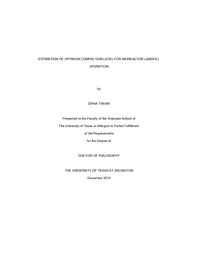
ATTENTION: The works hosted here are being migrated to a new repository that will consolidate resources, improve discoverability, and better show UTA's research impact on the global community. We will update authors as the migration progresses. Please see MavMatrix for more information.
Show simple item record
| dc.contributor.author | Tiwari, Dipak | en_US |
| dc.date.accessioned | 2015-07-01T17:50:35Z | |
| dc.date.available | 2015-07-01T17:50:35Z | |
| dc.date.issued | 2014-12 | |
| dc.date.submitted | January 2014 | en_US |
| dc.identifier.other | DISS-12957 | en_US |
| dc.identifier.uri | http://hdl.handle.net/10106/24966 | |
| dc.description.abstract | The effect of compaction on the degradation of MSW is important for the successful operation of bioreactor landfill. It has been a general tendency to compact working face solid waste as much as possible to gain more space. Previous studies has shown moisture content, moisture recirculation and ambient temperature were important components for degradation. There was a limitation on the compaction effect on degradation. Although several studies were conducted in the past to find the hydraulic conductivity of the waste, there was lack of work to find the optimum compaction to achieve sufficient flow inside the landfill and thus to enhance the biodegradation process.The current study has been focused on the compaction effect on the hydraulic properties of various waste and determining optimum range of density to maintain the flow in fresh waste. A certain compaction level is required for bioreactor landfill which can maintain uniform flow with sufficient drainage capacity. Besides flow criteria, compaction level is required for the microbial activity and can maximize methane gas production. Drainage capacity of the solid waste is an important parameter for the bioreactor landfill which is required to generate sufficient leachate. The tangent intersection methods were used to estimate the changing point on the curves, which were considered as optimum density. They hydraulic conductivity versus dry density gave the optimum density range from 482 to 520 kg/m3 and the corresponding range of hydraulic conductivity varied from 7.0×10-4 to 1.1×10-3 cm/s. The retained porosity versus dry density gave the optimum density range from 490 to 520 kg/m3 for various waste. The maximum retained porosity 46% to 51% for various waste. Similarly, the drainable porosity versus dry density gave the optimum density from 480 to 520 kg/m3 for various waste. The minimum drainable porosity was estimated as from 9% to 12% for various waste using different devices.Similarly, the study had been focused on the compaction effect on the degradation. MSW samples with the same physical characteristics were filled in three bioreactor cells at dry densities of 458, 572 and 686 kg/m3 designated as R1, R2 and R3, respectively. The rate of methane gas generations for compacted samples for reactor R1, R2 and R3 reached peak 315, 245 and 77 mL/kg/day, respectively. There was not big difference on methane gas generation between reactors R1 and R2 but reactor R3 produced very low methane. The reactors R1, R2 and R3 produced cumulative methane 52, 39 and 12.5 L/kg, respectively. The compaction ratio of reactors R1, R2 and R3 were in the ratio of 1:1.25:1.5, and the gas generation ratio as 4.16:3.12:1, respectively. The degradation level in reactors R1 and R2 were quite high as compared to reactor R3. Even though there was high degradation in reactors R1 and R2, the hydraulic conductivities were not varying but almost same in every month. There was not much degradation on the highly compacted waste reactor R3 but the hydraulic conductivity decreased every month which indicated that hydraulic conductivity decreased due to accumulation of gas rather than degradation by itself. It was general assumption that if the leachate generation is high, gas generation will also be high. The leachate generation was also decreased with compaction. While considering all above criteria to estimate the optimum density level, the dry density should be less than that of reactor R2 i.e. the dry density of 572 kg/m3. | en_US |
| dc.description.sponsorship | Hossain, Sahadat | en_US |
| dc.language.iso | en | en_US |
| dc.publisher | Civil & Environmental Engineering | en_US |
| dc.title | Estimation Of Optimum Compaction Level For Bioreactor Landfill Operation | en_US |
| dc.type | Ph.D. | en_US |
| dc.contributor.committeeChair | Hossain, Sahadat | en_US |
| dc.degree.department | Civil & Environmental Engineering | en_US |
| dc.degree.discipline | Civil & Environmental Engineering | en_US |
| dc.degree.grantor | University of Texas at Arlington | en_US |
| dc.degree.level | doctoral | en_US |
| dc.degree.name | Ph.D. | en_US |
Files in this item
- Name:
- Tiwari_uta_2502D_12957.pdf
- Size:
- 5.034Mb
- Format:
- PDF
This item appears in the following Collection(s)
Show simple item record


